I recently forced the creation of a DNA Circle at AncestryDNA by target testing a descendant of a common ancestor. This blog post offers some information about how I did it, and some of my reasoning for doing so.
AncestryDNA’s DNA Circles
AncestryDNA offers a tool called DNA Circles, which is a group of at least three individuals that share a common ancestor in their public family tree at Ancestry, and each member shares DNA identical-by-descent with at least one other person in the circle.
According to AncestryDNA, a DNA Circle “open[s] the possibility for AncestryDNA members to identify distant relatives with whom they do not share DNA IBD directly, but with whom they still have genetic evidence supporting their relationship.” Instead of relying on just triangulation, DNA Circles rely on the concept of a Genetic Network.
A DNA Circle requires at least three “family groups,” each of which is made up of anyone that is related at a level of first cousin once removed (1C1R) or closer. For example, a person who has tested their siblings, parents, grandparents, aunts/uncles, and first cousins would only create a SINGLE family group. To produce a DNA Circle, at least two other distinct family groups are required:
The DNA Circle creates a “Genetic Network” of shared DNA segments between the three or more different family groups. In the following image, a red line represents a shared DNA segment:
It is possible, but not required, that a single segment of DNA be shared among ALL three family groups; in other words, it is possible but not required that any of the segments of DNA be triangulated. In the example above, for example, none of the individual segments of DNA are shared by all three family groups (i.e, none are triangulated).
For much more about DNA Circles, be sure to see the DNA Circle White Paper.
Some Important Limitations
I’ll note at the start that there are several important limitations to DNA Circles that have to be considered. For example, information about the segments shared by the members of the Circle is not provided. Additionally, DNA Circles suffer from the same limitation that triangulation suffers; there are many reasons why the identification of the common ancestor could be incorrect (holes in trees, misattributed parentage, etc.).
Genetic Networks & Triangulation
Over the past few months, I’ve been working on a blog post about the use of Genetic Networks in genetic genealogy. I keep coming back to it, but I haven’t yet had the time to devote to it, unfortunately. (Although now I think THIS is that blog post!).
Essentially, the blog post will examine the concept of Genetic Networks, and how they might be used to supplement and/or work together with triangulation to help map segments of DNA to our ancestors. Although Triangulation is the gold standard, I’m not convinced that triangulation alone should be utilized for identifying IBD segments, or that triangulation alone should be utilized to assign segments to an ancestor or ancestral couple. I believe the idea of Genetic Networks, or sufficiently large groups of people that have segments of DNA which are shared by fewer than three members of descendants of a common ancestor, will potentially be useful as well (especially sufficiently large segments).
Earlier this year, AncestryDNA published a new graph which appears to have been created specifically to address the issue of triangulation, which they recognize is (correctly) important to traditional genetic genealogists. The graph, reproduced below, is a graph of how likely it is that three relatives share the same segment of DNA from a common ancestor. For example, the likelihood that three first cousins share a segment of DNA from their common grandparents is about 85% according to the graph; for second cousins and great-grandparents it is 60%; for third cousins and gg-grandparents it is 15%; and for more distant cousins it appears to be 1% or less:
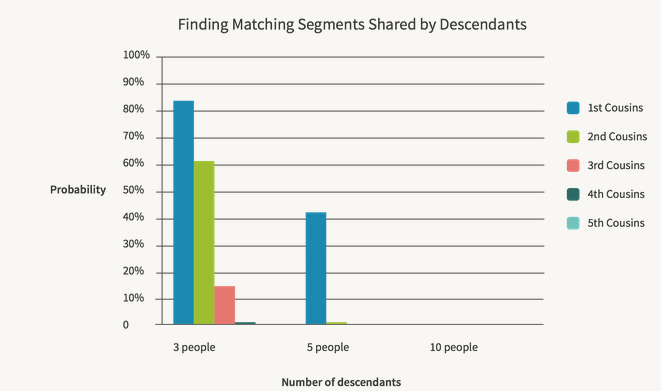
Based on my own data and experience, I don’t think the actual numbers and probabilities for triangulation are nearly as poor as the graph reports. For example, we see far too many triangulation groups in our results for the numbers to be this pessimistic. Further, the graph is oversimplified in some respects; I think we may be seldom looking at people in a Triangulation Group who are all at the same level. One or more members of the triangulation group may be 1, 2, or more generations closer to the ancestor, for example.
But the graph does make clear, and common sense dictates, that relying on triangulation alone misses the majority of the possible available genetic information. In other words, triangulation alone misses most of the DNA passed onto future generations by our common ancestors. That simply cannot be argued with; what we can disagree with is the extent.
While that might not be an issue for those of us working on just chromosome mapping our own DNA, it will be an issue for those of us trying to capture as much DNA from an ancestral couple as possible (which will be a more prominent goal in the near future as we do more large-scale projects, including recreating the genomes of our ancestors).
I think Genetic Networks might be one way to try to recapture the vast amount of information missed by triangulation alone. Hopefully this post will create conversation about how we can go about doing that in ways that are robust.
The Colwell Family DNA Circle
 Hamilton and Susanna (Stein/Steen) Caldwell had eleven children, all born in or around County Tyrone, Ireland in the mid- to late-1800’s. In 1883, the couple and their eight youngest children left Ireland to join members of their family in Ellisburg, Jefferson County, New York. There, Hamilton and Susanna bought several large farms and had a prosperous few years as their family grew.
Hamilton and Susanna (Stein/Steen) Caldwell had eleven children, all born in or around County Tyrone, Ireland in the mid- to late-1800’s. In 1883, the couple and their eight youngest children left Ireland to join members of their family in Ellisburg, Jefferson County, New York. There, Hamilton and Susanna bought several large farms and had a prosperous few years as their family grew.
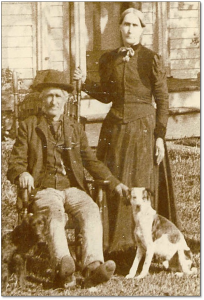
Hamilton and Susanna (Stein/Steen) Caldwell/Colwell
Today, descendants of Hamilton and Susanna Colwell family (as the name is used by all descendants of the couple) number in the many hundreds and possibly 1,000 or more.
Colwell Descendants at AncestryDNA
When I tested at AncestryDNA, I discovered that I shared DNA with another descendant of the Colwells, a fourth cousin once removed (4C1R). This person is called “Existing Test-Taker” in the images below.
I also tested other members of my close family who were descendants of the Colwells, all of whom were related to me at 1C1R or closer.
However, since there were only two family groups (see below), there was no Colwell DNA Circle.
To create and see a DNA Circle, we would need a third family group.
Creating a DNA Circle
So, to hopefully force the creation of a DNA Circle, I target tested another descendant of the Colwells, this time a descendant of a different, third one of the 11 children of the common ancestral couple. If this person shared DNA with either me or Existing Test-Taker, then a DNA Circle should be created. In this case, I had the extra benefit of this person being two generations closer to the ancestral couple than me, and one generation closer than the Existing Test-Taker. I did have a great-uncle tested so he and the Targeted Test-Taker would be 3C.
Sure enough, within a few days of the test results appearing, two DNA Circles appeared for the ancestral couple:
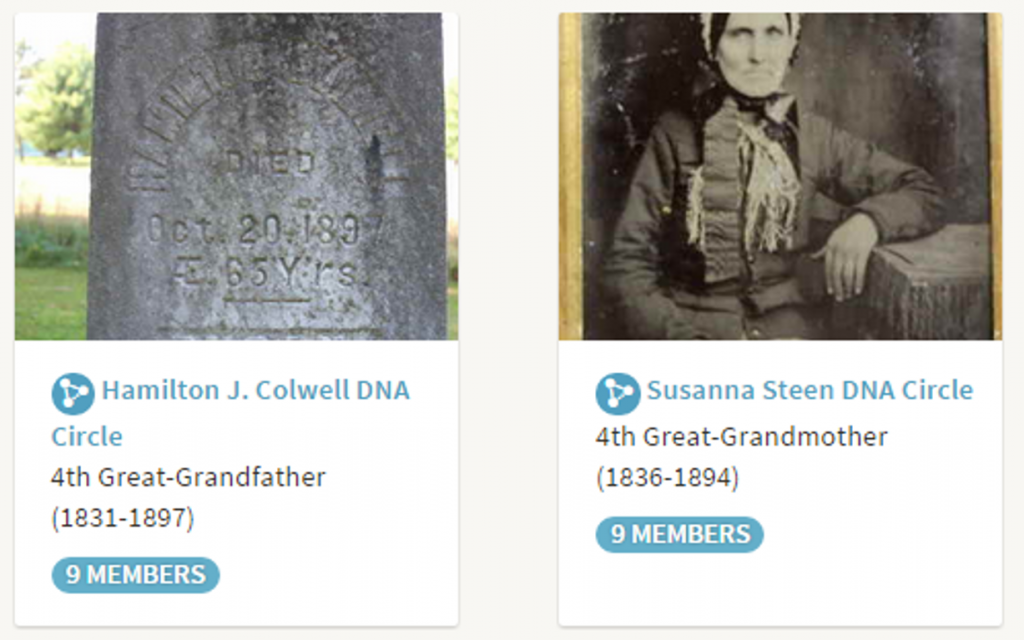
The DNA Circle is made up of only the three family groups, and each family group shares DNA with every other family group:
My hope, however, is that new family groups will be added to this Genetic Network, particularly those that would only match the Existing Test-Taker, since I would not see these individual with Colwell Family segments in my own match list or that of the Targeted Test-Taker.
The Usefulness of Genetic Networks
I think that the applicability of Genetic Networks will depend on two competing facts: first, that a robust Genetic Network with closely-related descendants will comprise individuals that would show up in your match list anyway; and second that a less robust Genetic Network will involve most distant relatives and will increase the probability of relationships through multiple family lines (known and/or unknown).
The first scenario will potentially alleviate (but of course not prevent) the likelihood that the large amount of sharing is due to other relationships, while the second scenario will potentially recapture more of the ancestral couple’s DNA that would otherwise be unidentifiable.
So if we don’t triangulation a segment that is shared within a Genetic Network, how do we ensure that the segment is from the ancestral couple? I don’t think there is a clear answer to this yet, but I also don’t believe it is impossible, or that we should ignore Genetic Network theory as a result. After all, we know that even the triangulation gold standard can fall prey to this issue.
AncestryDNA claims to do this several ways.
For example, they only go back 6 generations with DNA Circles, since their research showed that descendants of an ancestor who lived more than six generations ago have more DNA in common with other descendants of that ancestor than they’d be expected to (meaning that they are more likely to be related through multiple lines).
Further, AncestryDNA defines this issue as W(Inheritance), which is “the confidence that the individuals have an IBD match due to the shared ancestor in question (as opposed to from another ancestor or from more distant genealogical history).” To calculate W(Inheritance), they use an algorithm that takes into account: (1) direct-line pedigree size, (2) number of [KNOWN] shared ancestral couples, and (3) the generational depth of the shared MRCA couple.”
Essentially, to lessen the likelihood that other lines are responsible for the sharing within the Genetic Network, AncestryDNA only goes back 6 generations, and heavily weights trees with a greater number of direct-line ancestors (the theory of course being that the more complete the tree, the less likely that sharing could come from behind a brick wall or other hole in the tree).
This almost certainly is not enough, and I’m sure AncestryDNA is working to refine DNA Circles. At the same time, genetic genealogists should explore ways to lessen the impact of these problems when using Genetic Networks.
Future Directions
So what might be the purpose of this exercise? Could the creation of a DNA Circle actually be beneficial to my research? And this might be the same question, but can we make Genetic Networks workable, and can they help me in any way?
In addition to the discussion above (or perhaps as a supplement to it), here are several reasons that the Genetic Network approach might be useful:
- The new Colwell Family DNA Circles are now waiting for other descendants to join. This could potentially include descendants that don’t share segments of DNA with me and thus would not ever appear in my match list. I’m also hopeful that two or more of the existing family groups might eventually help form new DNA Circles with descendants of the ancestors of Hamilton and Susanna (Steen/Stein) Caldwell (whom I don’t know).
- I am amassing DNA to help recreate portions of the genomes of Hamilton and Susanna (Steen/Stein) Caldwell, which might be of immense value in the near future as we develop tools to use recreated ancestral genomes. Although I can amass this by testing at any company, by also having them at AncestryDNA – in other words, by creating a Genetic Network – I can use the DNA Circle as bait.
Future Directions for Genetic Networks
It’s easy to dismiss Genetic Networks. They are certainly fraught with problems, some of which triangulation must continue to face as well. However, beware anyone that dismisses Genetic Networks or DNA Circles out of hand.
It is also very easy to look at an existing tool that we know works – triangulation – and believe that it is the only way to achieve our goals. It won’t be, especially as we continue to reach critical mass in the databases for all sorts of new tools and new methods of analysis.
And further, it can’t be. Although triangulation works, is too slow and time intensive for 90% of genealogists, and it won’t allow us recreate sufficiently large portions of genomes of our ancestors unless many, many, many thousands of people are doing triangulation on a massive scale.
I don’t have all the solutions, but I do believe we should have these discussions as new tools develop, rather than assuming that our existing tools are the only ones we should use.
Postscript
To see a real-life example of a genealogical question answered using a combination of Triangulation and a Genetic Network, see my last post about a new article in the NGSQ. In this article, the author uses segments of DNA among descendants of ancestral couple to support a relationship. Some of the segments triangulate among three or more descendants, while some do not triangulate and are shared only among two descendants. Although the NGSQ is subscription only, it is also available at more than 1,000 libraries around the world.
- Thomas W. Jones, “Too Few Sources to Solve a Family Mystery? Some Greenfields in Central and Western New York.” National Genealogical Society Quarterly 103 (June 2015): 85-103.
Post-Postscript (Added 26 July 2015):
Not surprisingly, the always-at-the-forefront Ann Turner has an essay available entitled “The Trouble with Triangulation” which discusses many of these issues. Apparently published a few months ago in April, I missed this terrific essay. I strongly suggest reading it if you’re interested in Genetic Network theory!
.
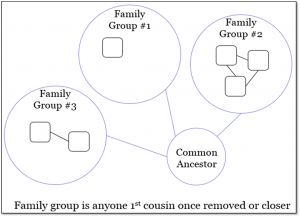
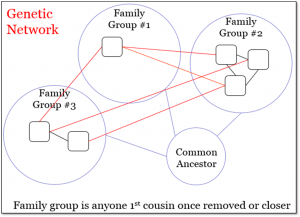
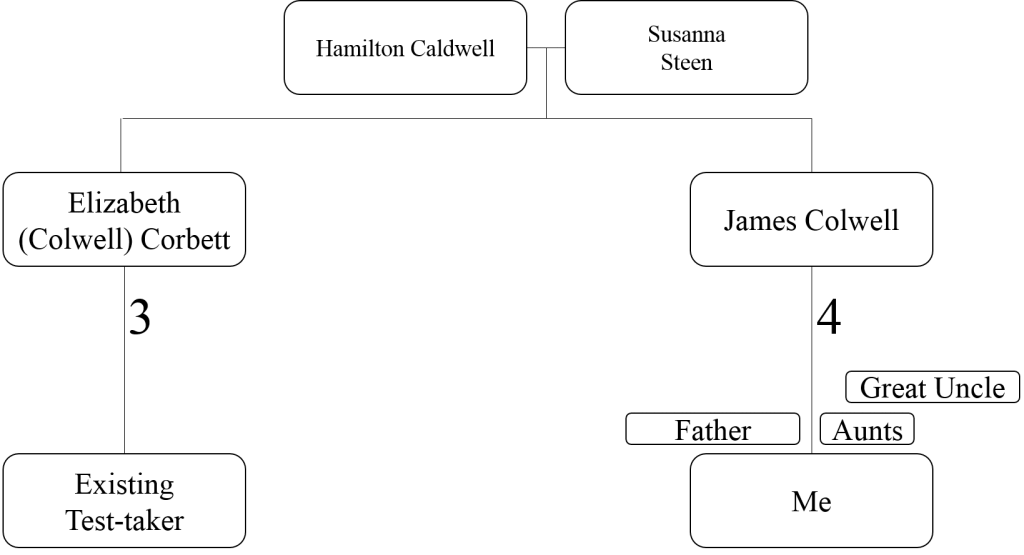
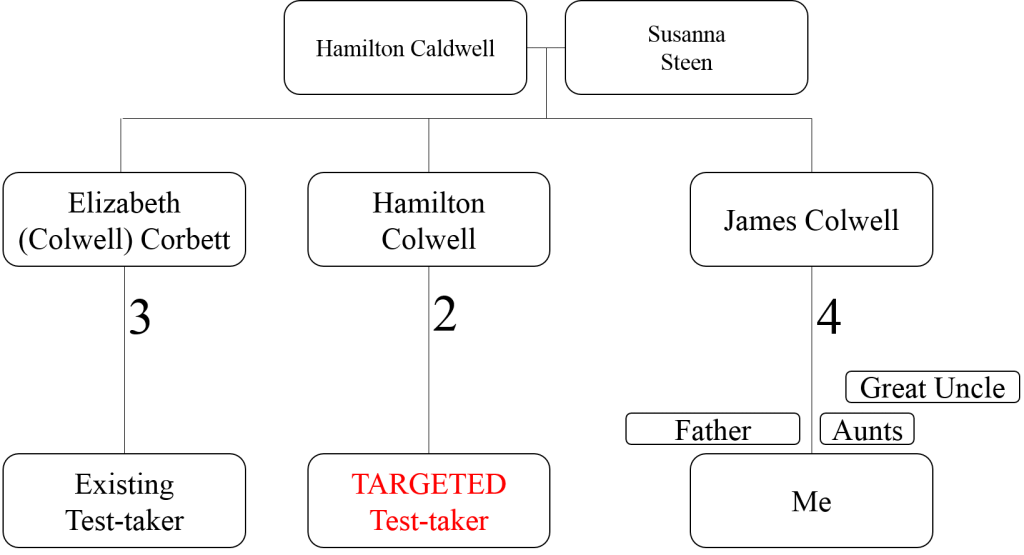
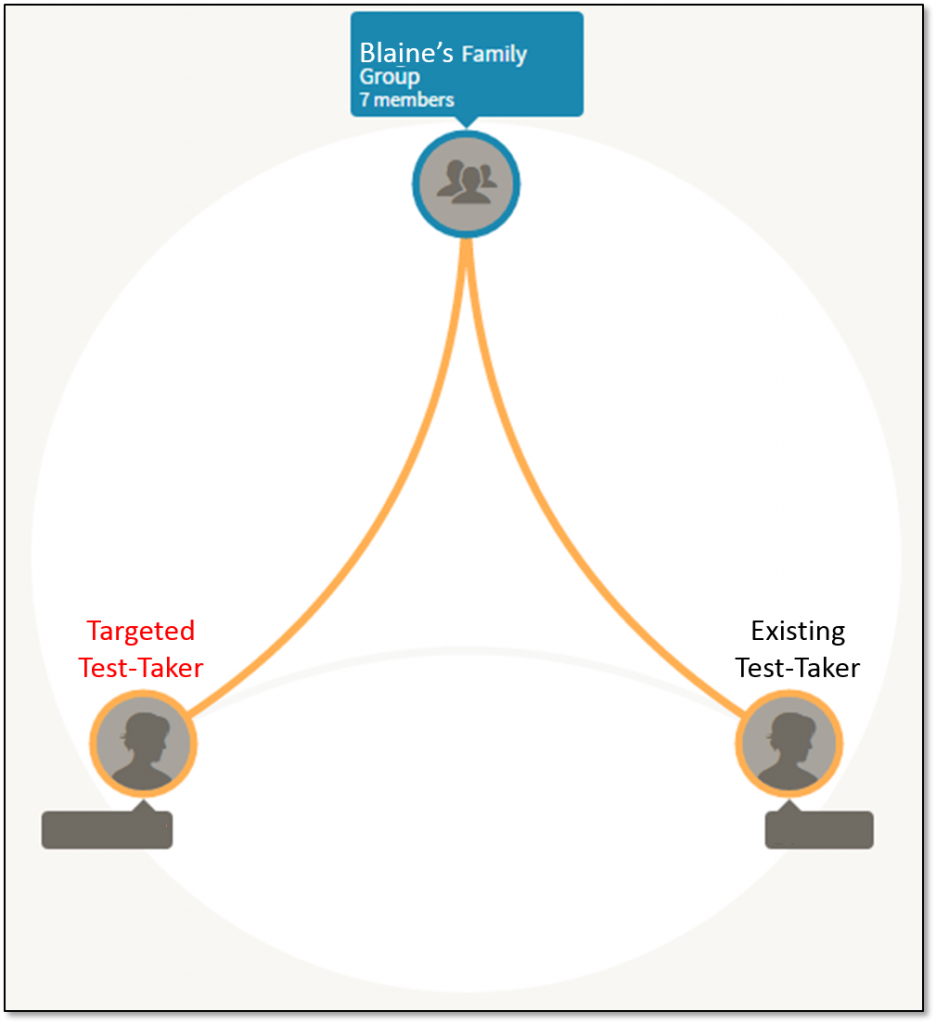
I concur with many of the points in your essay, Blaine. I illustrated some of them with actual segment data in my essay “The Trouble with Triangulation.”
http://tinyurl.com/TheTroubleWithTriangulation
“It is also very easy to look at an existing tool that we know works – triangulation – and believe that it is the only way to achieve our goals.”
This is big strawman. Valid and useful alternatives to triangulation will be universally applauded.
If Ancestry’s DNA Circles have produced any genealogical success stories, I’d love to hear them.
The purpose of this post is about Genetic Networks; DNA Circles are just one tool for forming a Genetic Network. For me personally, the question would be “If Genetic Networks have produced any genealogical success stories, I’d love to hear them.” We have at least two that are written up, the NGSQ article cited in the blog post, and now Ann Turner’s essay.
Plus, it’s clear from your Facebook posting that you embrace the concept of Genetic Networks, but it’s important to know that not everyone is familiar with them, or believe they can help us achieve our goals.
There was a recent blog post at Ancestry about a NAD
http://blogs.ancestry.com/ancestry/2015/07/22/ancestrydnas-new-ancestor-discoveries-solves-a-100-year-old-family-story/
I wouldn’t consider my essay an example of a success story (yet), since I haven’t been able to make connections with the unknown relatives.
True Ann, but I don’t think I define “success story” the same way others do. You don’t need to smash through a brick wall or find an adoptee’s parents for a success story in genetic genealogy. Some genetic genealogists may never do that. For me, a success story can be as simple as identifying a segment of DNA belonging to an ancestor that you wouldn’t have found without a Genetic Network, for example.
Thank you, Ann
My 25th DNA Circle appeared this week and what is most valuable about it is not just receiving “some” confirmation that this ancestral couple appears to be genetically related, but discovering what happened to one of their male offspring whose family I lost due to his early death. One of his descendants tested and made up a 4th DNA Circle. Clicking on those Circles and examining their trees is very useful for genealogy! I agree with your points Blaine….when you see for yourself that different siblings inherit different DNA from their parents, and take that observation back in time, you realize that “triangulation on overlapping segments” cannot be the only way to prove a genetic inheritance exists. You’re also correct that 90% of genealogists are not going to do chromosome mapping (with existing tools) especially once they realize that their siblings and cousins inherited different DNA segments from common ancestors. To tell this 90% that a DNA Circle or genetic network concept is not valid is not only discouraging, it’s simply not true.
All good points Mary. Triangulation and chromosome mapping are incredible tools, but they are incredibly time-consuming. Most people in the field are vastly overestimating the number of people who are actually doing any triangulation or mapping. Indeed, the percentage of people that even look at segment data is very, very small.
Does that mean we shouldn’t have segment data? No, of course not. But it does mean that we need better tools to assist us with triangulation and chromosome mapping in a robust, accurate, and time-efficient manner.
“Most people in the field are vastly overestimating the number of people who are actually doing any triangulation or mapping.”
I doubt it. It’s very clear that a lot of people haven’t been drawn to genetic genealogy yet. I think most of us who are “in the field” have noticed that there aren’t large numbers of people filling up our inboxes with requests to collaborate. Genetic genealogy needs to be made easier. I think that can be done. And I think it can be done (and has to be done) without sacrificing our gold standard tools and our gold standard evidence. But so far, AncestryDNA has been marginalizing our gold standard and has created some awful and unnecessary barriers in the use of our test results. That’s especially unfortunate because AncestryDNA has outsize influence on how genetic genealogy is perceived by the broader public. They’ve blunted the full potential of DNA testing for their customers while obscuring the difficulty of verifying the clues. AncestryDNA is promoting the use of DNA for genealogy research while presenting a distorted picture of the proper use of DNA evidence.
It’s always interesting how this plays out. Before I had my mother’s adoptive mother’s tree connected and I saw the DNA circle appear and disappear. Two weeks ago I finally found my mother’s biological mother’s family and made the appropriate connection with our closest match who is a 1C1R to my mother, 2C to me. Predicted 2nd Cousin [Possible Range 2nd – 3rd Cousins Extr Hi] for me, and Predicted 2nd Cousin [Possible Range 1st – 2nd Cousins Extr Hi] for my mother.
A woman who is of that same family is a Predicted 3rd Cousin [Possible Range 3rd – 4th Cousins Extr Hi] to my mother, while she is a Predicted 4th Cousin [Possible Range 4th – 6th Cousins. From what I calculated, she is a 2C to my mother, but thought the amount of DNA share was a bit less than expected. BTW, none of these people want to upload to GEDmatch to compare.
This woman told me that her mother was actually adopted into the family, and not related to the family. And now I do see the DNA Circle appearing (last week). I thought it was interesting, knowing that Ancestry could not predict if we inherited those same segments. Even if we did (if we were to look through GEDmatch), I may or may not be able to assign the exact segments to a particular ancestor. I probably could if they were large enough. But the more distant ones, as in this particular example, would be more challenging.
Kalani – thank you for the comment! As someone approaching the Genetic Network idea with an endogamous background, it’s great to get your input. It will be interesting to see how this particular scenario plays out! Any guesses?
I don’t know what to expect really. Even though not just Hawaiians but I know Maoris and the Samoans and I think Tongans too, all have ancient genealogies going back a lot of generations, probably to the same exact people, it is still difficult to tell. It’s no different than comparing say Mary Ana to Maria Ana, to Marie Anne. That’s what these genealogies look like to each other. And comparing our segments to each other, they’re just multiple and how do you really figure out who actually gave us those particular segments? It’s hard to tell. Even with this recent breakthrough, only to find out that one of our common matches and/or DNA Circle person just wasn’t closely related to use, yet showed up closely related to us, at least by Ancestry’s standards to say that they were like a 3rd – 4th cousin and their genealogy matched.
To date, the most useful aspect of my Ancestry circles has been to check out the trees of my cousins for information I did not have. I find that most trees are accurate through great-grandparents. The information I get on the collateral families often tells me when a migration occurred. These migrations tended to alter the gene pools. So, for example, one of my 4th great grandparents migrated from Bedford County, VA, to TN around 1800 with most of his adult children and others. The son who remained in Bedford was my ancestor. I am much more likely to match the Bedford descendants than the TN ones because I am related to the Bedford ones on multiple lines. The TN descendants are also much more likely to find matches among that population for the same reason – intermarriages amongst the same families.
To change the subject, gedmatch used to provide triangulation charts. Which companies, if any, are doing them now?
Jane – DNA Circles are definitely good for connecting with cousins. GEDmatch is still doing triangulation; for example, it has the “Triangulation” tool as a Tier 1 Utility (Tier 1 tools are available for a donation of $10 for each month of access).
Thanks, Blaine! I have not been paying careful attention to changes at gedmatch. The triangulation tool used to be free. I just discovered that I match someone who is likely to be distantly related on 5.3cm, 726 SNPs on one chromosome (I searched at the 5.0 cM threshold). Do you have any idea what the probability is that a match on such a segment is due to chance? Is there an online site with any of this statistical information?
Jane – you should check out the graph from the 23andMe paper in this blog post: https://thegeneticgenealogist.com/2014/12/02/small-matching-segments-friend-foe/
A large number of 5 cM segments are false, while some are absolutely real IBD segments, and it’s difficult to determine which are which.
I read it. I know that small segment matches may be false. The graph did give me some idea of probabilities but was still too vague to pin down actual chances. And I do realize how difficult this must be when endogamy is involved.
Has anyone done a study with, say, rats? Here the pedigrees can be known, and even endogamy can be tested.
DNA Circles feel like a step forward and a step back to me. It makes perfect sense for Ancestry’s algorithms to add Cousin B to a Circle if they match Cousin A and Cousin C with the same ancestors. I wish the tool was a little more robust and didn’t rely as much on people’s trees, but it’s a solid start. But it’s clear that Ancestry does *not* believe in segment matching the way it’s commonly practiced, saying there’s zero chance five 2nd cousins can share data on the same segment. I don’t know too many people that share this view. But if Ancestry feels Circles solve the problem, then we’re further than ever from getting data that we think is valuable from them. At a minimum I wish they would explain what is going on with these multiple long (20cM+) segment matches we all have. Are they all IBS / pile-ups? And how to explain – as you point out, Blaine, the many triangulation successes.
First of all, the probability is not zero. If you squint a bit, you can see a bar down in the 1% range. Second, I see an analogy to the “birthday problem.” The chances that you and a specific person will have the same birthday are 1 in 365. There’s a 50% chance that SOME pair in a group of 23 people will have the same birthday, due to the fact that there are so many possible pairs of people.
http://betterexplained.com/articles/understanding-the-birthday-paradox/
What we can see when we look at our triangulated matches are the ones that do pass the test, not the large number of possible sets of 5 cousins that don’t share a segment.
What I find more disturbing about AncestryDNA’s method is the large proportion of cases where a child has a match not found in either parent. Few people have reported their stats, and those may be biased toward the high end, but the numbers I’ve seen are upwards of 25%. These must be either false positives in the child or false negatives in the parent.
We’re getting off the topic of circles, but this is interesting. I know very little about genetics, but it seems that one possible explanation for a child match but no parent match is recombination, especially in endogenous populations.
And I would hypothesize that certain genes must be inherited in groups (segments) which might explain how large segments are passed from generation to generation. It would be nice to know exactly which segments on each chromosome are not subject to recombination.
By the way, I tried Ann Turner’s 23andMe / Countries of Origin approach and it led me right to a new, verified 4th cousin twice removed. I also know a lot more about my mystery 3rd cousin who still hasn’t accepted my invitation. Thanks for the tip, Ann!
I have a DNA circle with 103 members. Her spouse 102. One child with abt 70.
There r good examples of identifying Bad NAD and good NADs.
Bad NADs have big circles with u matching 2 or 3. Good NADs match 4 or more.
If such circles help ur research, email me at acd333@hotmail.com.
I can send u an invite.
Somebody posted a link to this today– may have even been you!
Thanks for the explanation of how circles work. Ive been puzzling why the maternal great grandparents have no clicles like I do on the paternal size. I knew enough *people* had tested to show up, but apparently, we’re all part of the same Family Group! Family size on both maternal lines is “small” at 5 children each (and only folks from 2 separate lines have tested); family size on the paternal lines is 10 children each. 🙂
Thanks a bunch for sharing this with all folks you really recognize what
you are speaking about! Bookmarked. Kindly additionally seek advice from my site =).
We may have a link exchange contract among
us